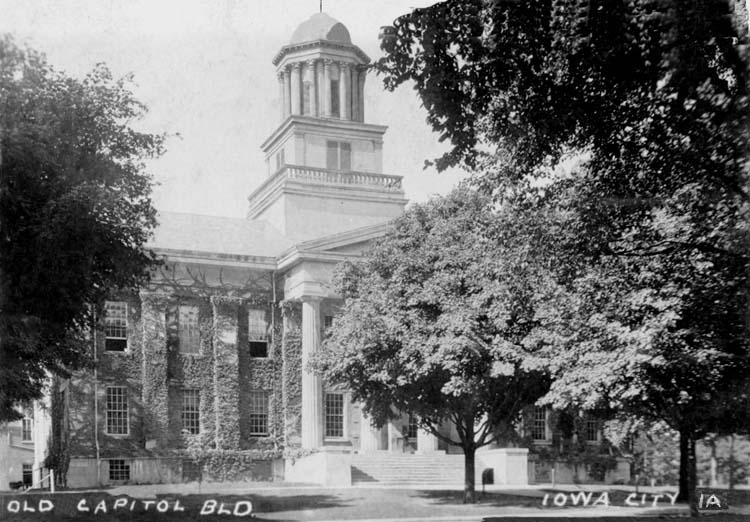
Erected
during the 1840s, Old Capitol first served as home base for Iowa
territory,
became state headquarters in 1846, and finally was inherited by the University
of
Iowa with departure of state offices to Des Moines in 1857.
The postcard image is from author’s collection.
|
By
Bob Hibbs
Uncertainty
reigned in Iowa City from its 1839 founding until state government was moved
to Des Moines 18 years later.
Even
though Iowa City has been designated Iowa’s “permanent capital,” there
seemingly was an inherent belief that the seat of government should be located
near the center of the area governed.
Exact
boundaries weren’t settled until statehood was achieved in 1846, just two
years after Congress had rejected an Iowa proposal that its boundaries stretch
north to Minneapolis. With statehood came definite boundaries, thus permitting
clear battle to be joined over choosing a central site.
Iowa
City was barely seven years old when legislators meeting in Old Capitol
created a commission to select a new seat. After a long 1847 search, a site
was chosen “on a beautiful prairie” in Jasper County and named Monroe
City.
Lots
were surveyed and sold – the same procedure followed as when Iowa City had
been located in May 1839 on “the most eligible point” in Johnson County.
But, Monroe City was not to be. The legislature ordered it abandoned two years
later with refunds.
Arguments
continued in the chambers of Old Cap through three subsequent legislative
sessions until Des Moines finally was selected in 1855 – nine years after
the first organized effort to remove the capital from Iowa City.
Coincidentally, the first railroad also reached Iowa City in 1855.
Two
more years passed before Gov. James Grimes could officially declare that as
set out by a newly-adopted state constitution the new capital was Des Moines.
That 1857 document, hammered out within the walls of Old Cap, remains in use
today, albeit with 46 amendments.
But,
with no railroad beyond Iowa City, an arduous task faced those moving the
state library, archives and furnishings 120 miles. The Great Western Stage
moved the retinue of senior officials free of charge. In a four-horse coach,
their journey began Thursday, Nov. 5, 1857, with Iowa City driver Joseph
Braggs at the reins.
As
the stagecoach passed below Old Cap, passengers bid ceremonial farewell to the
home of territorial and state government for nearly two decades. They arrived
in Des Moines near noon the next day.
State
Treasurer Martin Morris personally paid for wagon transport for deputy office
holders. They traveled separately, pausing a night about half way to Des
Moines in Brooklyn near Grinnell. Sleet and rain greeted them next morning,
and by evening a snowstorm was raging.
A
second night found the group at a farmhouse 25 miles from their destination.
More snow overnight so obscured the route that their driver quit. A local
farmer familiar with the terrain used his lumber wagon to carry the deputies
the final miles, arriving Sunday afternoon, two days after their counterparts.
Four
office safes made yet a different journey. They, too, were caught in rain, mud
and snow. A heavy Treasurer’s Office safe was abandoned in hiding near a
creek in Polk County, to be retrieved after the storm abated and the ground
froze solid.
An
ox cart eventually hauled the safe in, gaining hearty cheers from officials
who found in tact the gold and silver coins from which their wages were to be
paid.
Both
legislators and delegates to the 1857 constitutional convention in Old Cap
agreed that in place of state government, Iowa City should have “the State
University.”
In
his 1939 Iowa City centennial history, Ben Shambaugh writes that the departure
of state government “simply marked the transition from legislation to
education.”
A
UI professor himself, Shambaugh says that by “preferring professors to
politicians” Iowa City received the better of the bargain. Point granted!
Next
Saturday: 1,400 miles by handcart
from Iowa City to Salt Lake.
Bob
Hibbs collects local postcards
and other historic ephemera and researches history related to them. |